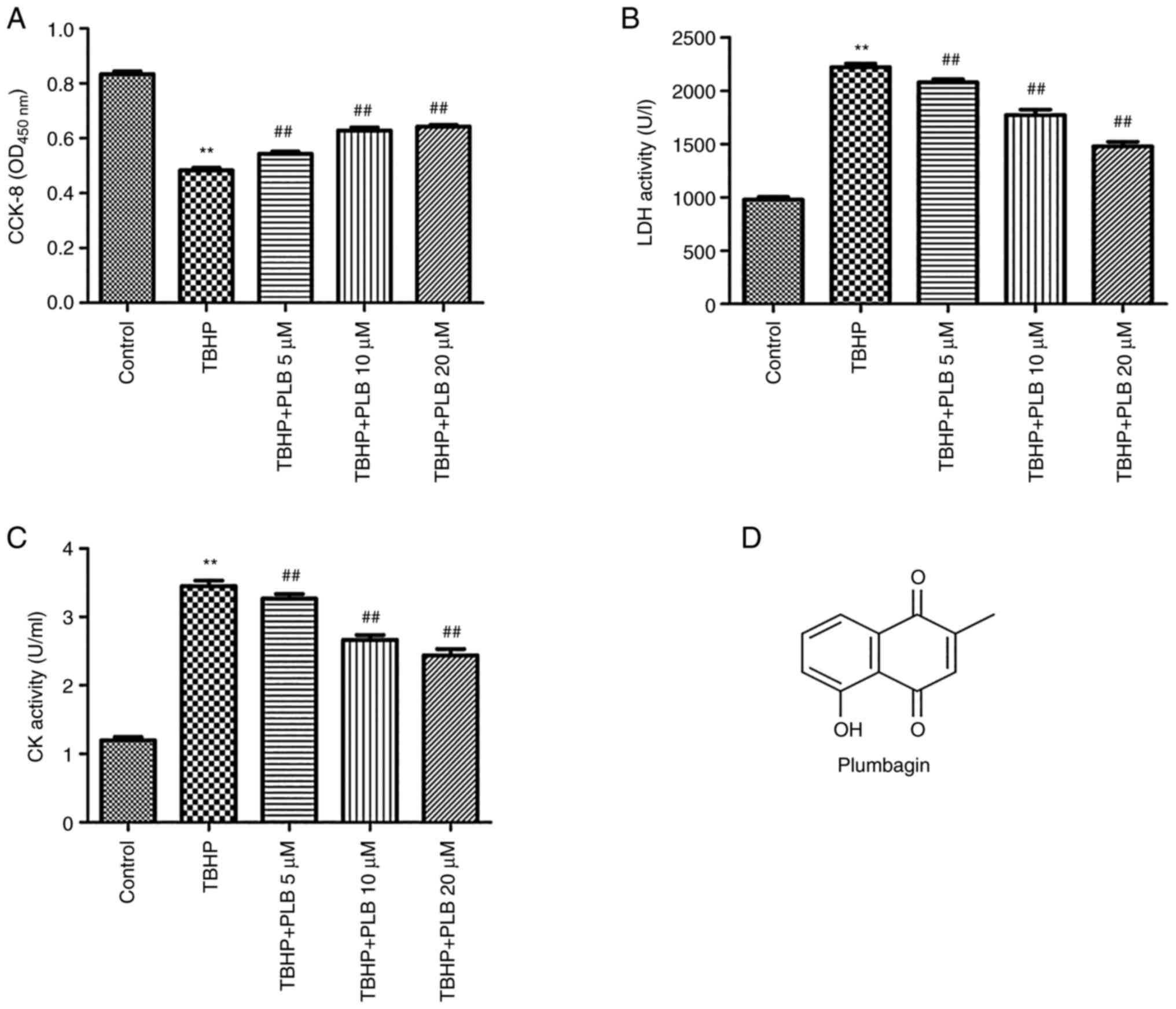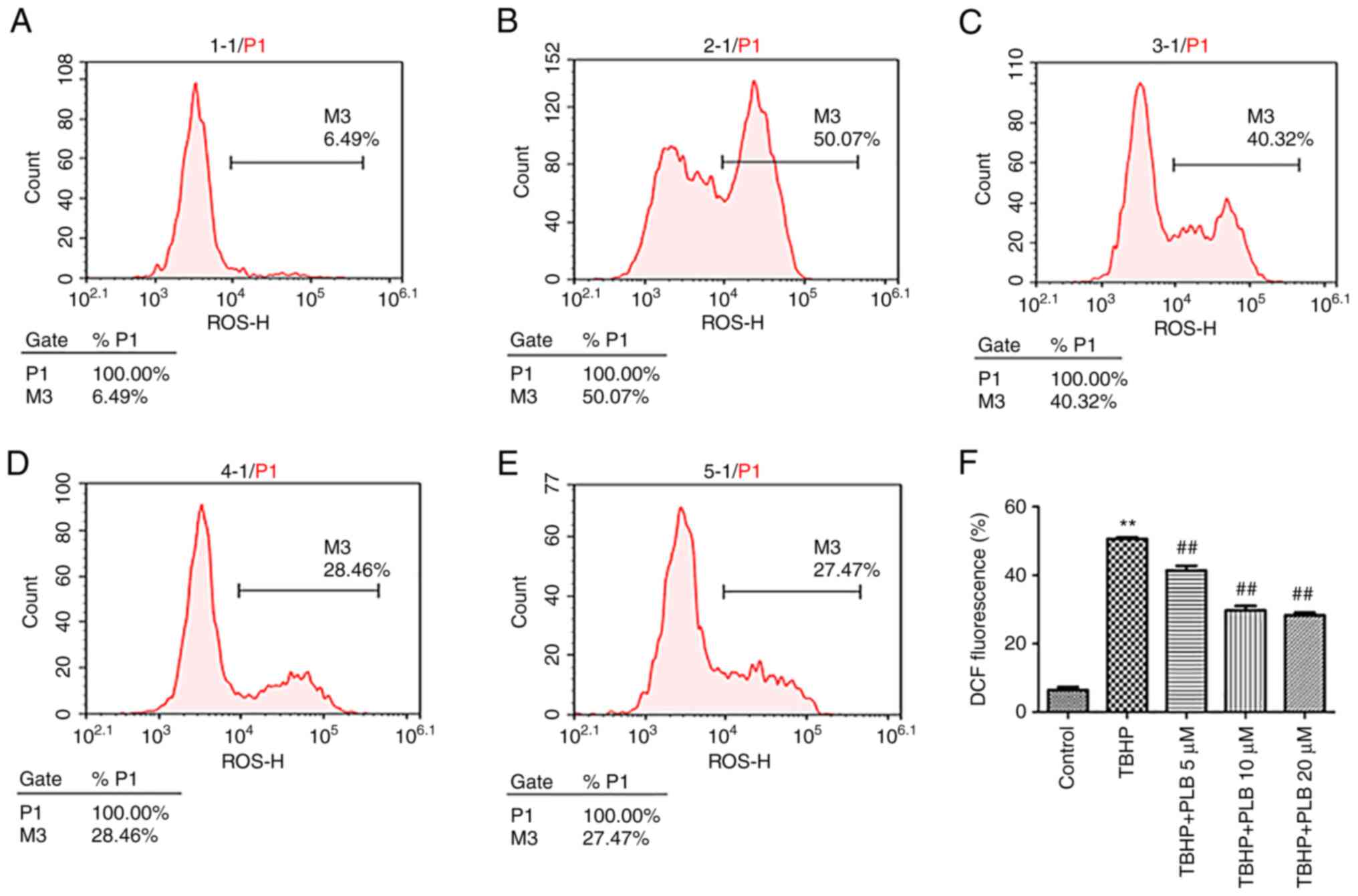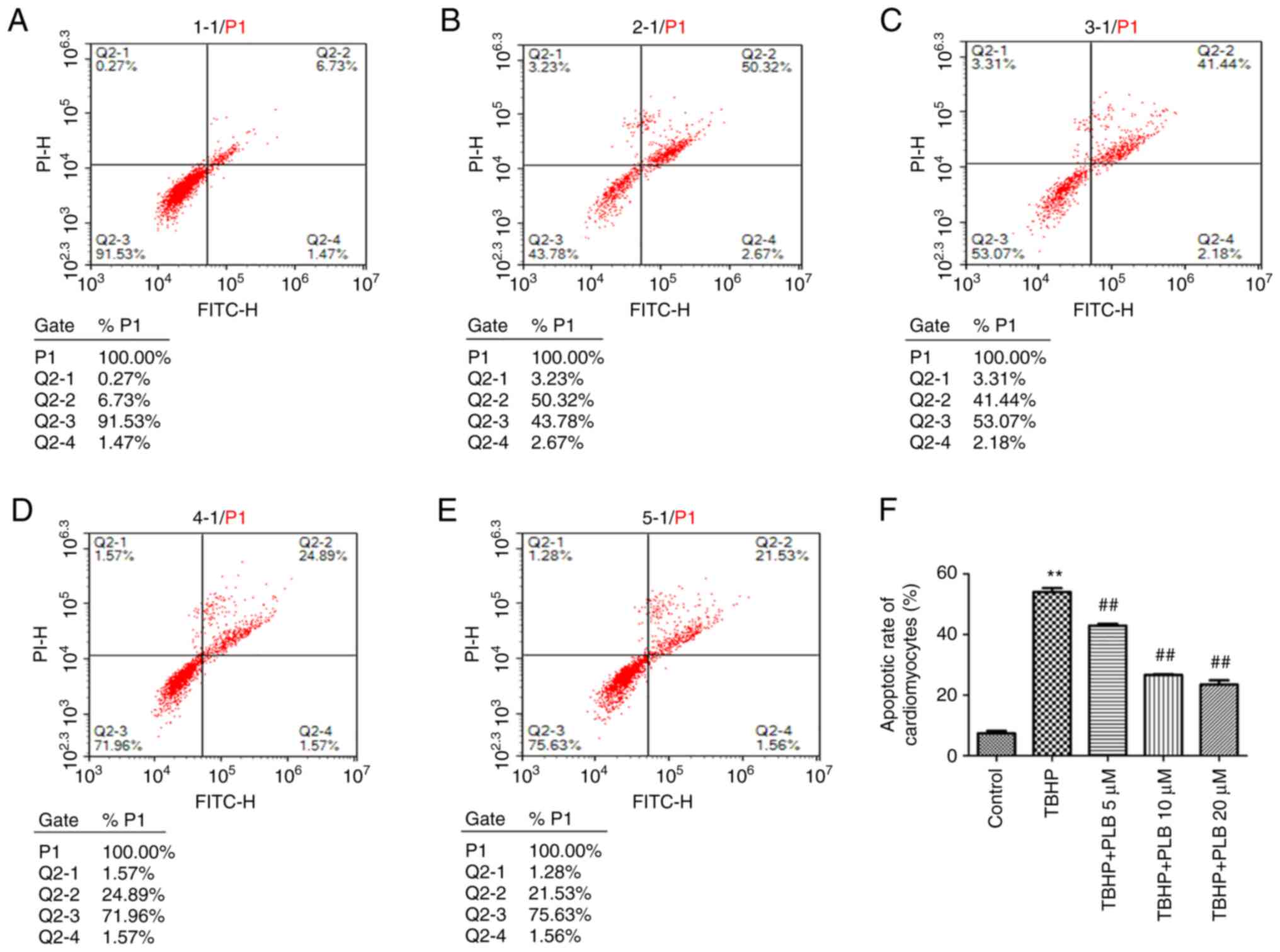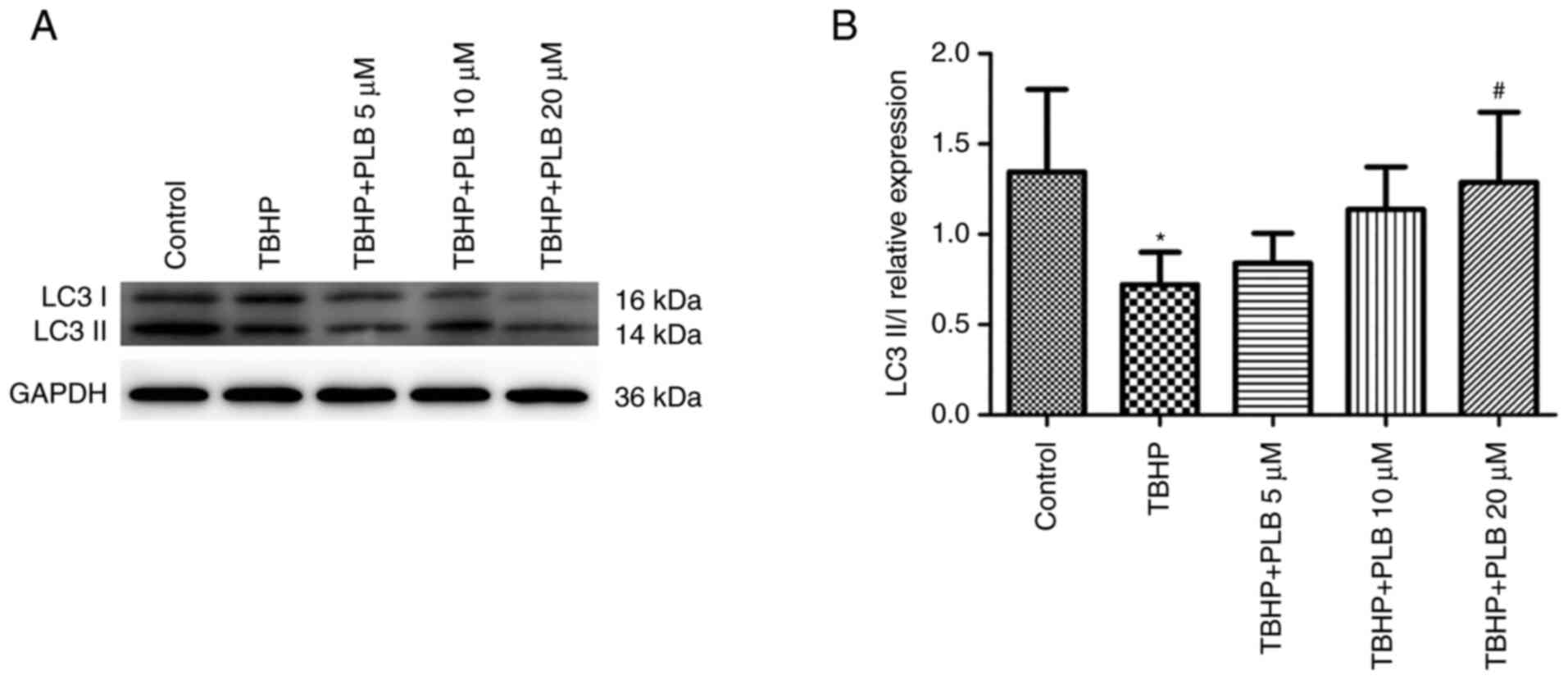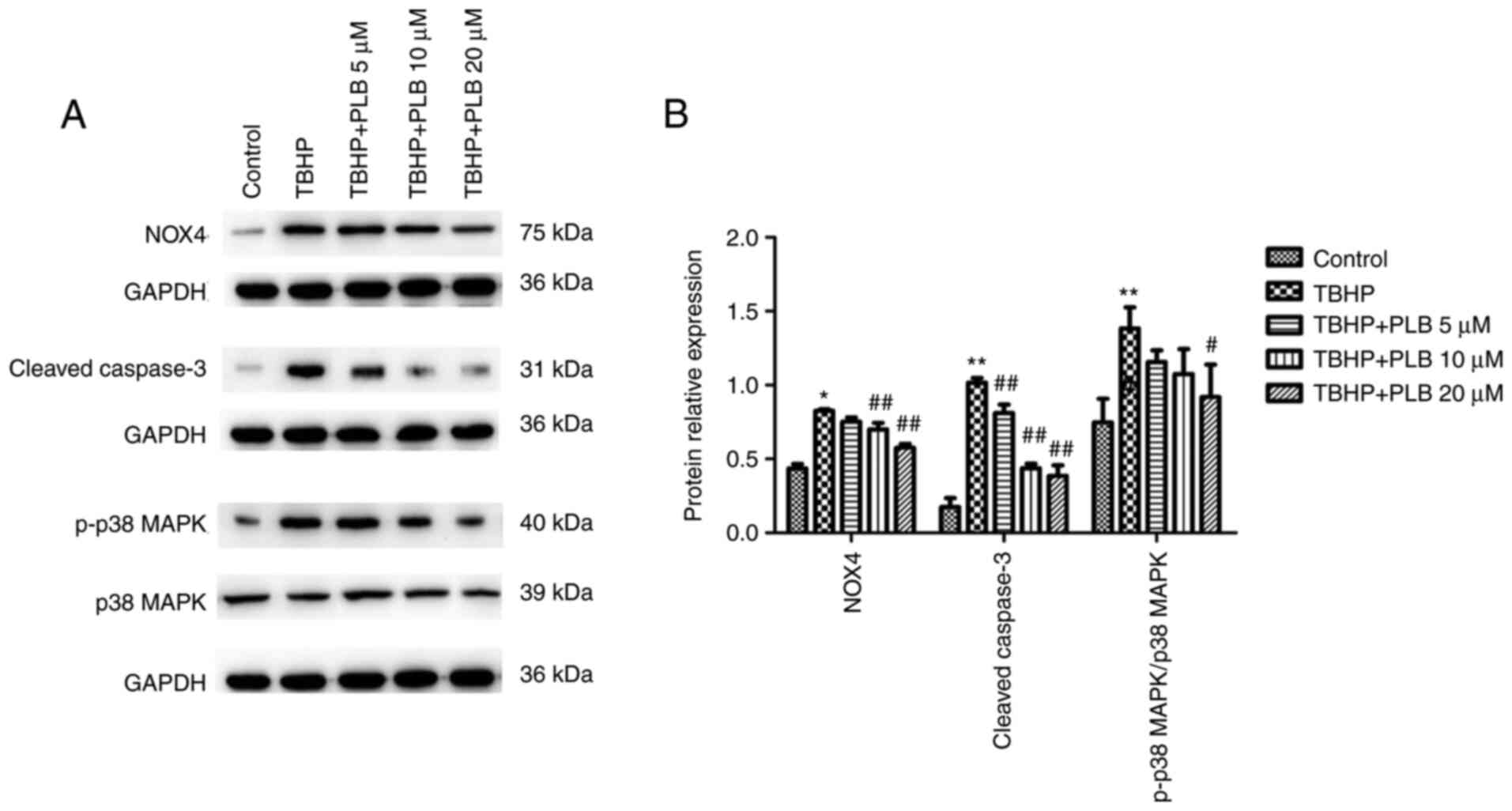|
1
|
Syama HP, Arya AD, Dhanya R, Nisha P,
Sundaresan A, Jacob E and Jayamurthy P: Quantification of phenolics
in Syzygium cumini seed and their modulatory role on tertiary
butyl-hydrogen peroxide-induced oxidative stress in H9c2 cell lines
and key enzymes in cardioprotection. J Food Sci Technol.
54:2115–2125. 2017.PubMed/NCBI View Article : Google Scholar
|
|
2
|
Arslan F, Bongartz L, Ten Berg JM, Jukema
JW, Appelman Y, Liem AH, de Winter RJ, van 't Hof AWJ and Damman P:
2017 ESC guidelines for the management of acute myocardial
infarction in patients presenting with ST-segment elevation:
Comments from the Dutch ACS working group. Neth Heart J.
26:417–421. 2018.PubMed/NCBI View Article : Google Scholar
|
|
3
|
Neri M, Riezzo I, Pascale N, Pomara C and
Turillazzi E: Ischemia/Reperfusion injury following acute
myocardial infarction: A critical issue for clinicians and forensic
pathologists. Mediators Inflamm. 2017(7018393)2017.PubMed/NCBI View Article : Google Scholar
|
|
4
|
Siu KL, Lotz C, Ping P and Cai H: Netrin-1
abrogates ischemia/reperfusion-induced cardiac mitochondrial
dysfunction via nitric oxide-dependent attenuation of NOX4
activation and recoupling of NOS. J Mol Cell Cardiol. 78:174–185.
2015.PubMed/NCBI View Article : Google Scholar
|
|
5
|
Kim EK and Choi EJ: Pathological roles of
MAPK signaling pathways in human diseases. Biochim Biophys Acta.
1802:396–405. 2010.PubMed/NCBI View Article : Google Scholar
|
|
6
|
Zhou QL, Teng F, Zhang YS, Sun Q, Cao YX
and Meng GW: FPR1 gene silencing suppresses cardiomyocyte apoptosis
and ventricular remodeling in rats with ischemia/reperfusion injury
through the inhibition of MAPK signaling pathway. Exp Cell Res.
370:506–518. 2018.PubMed/NCBI View Article : Google Scholar
|
|
7
|
Yong R, Chen XM, Shen S, Vijayaraj S, Ma
Q, Pollock CA and Saad S: Plumbagin ameliorates diabetic
nephropathy via interruption of pathways that include NOX4
signalling. PLoS One. 8(e73428)2013.PubMed/NCBI View Article : Google Scholar
|
|
8
|
Zhang Q, Liao X and Wu F: The
naphthoquinone plumbagin suppresses ADP-induced rat platelet
aggregation through P2Y1-PLC signaling pathway. Pak J Pharm Sci. 30
(2(Suppl.)):S573–S578. 2017.PubMed/NCBI
|
|
9
|
Guida M, Maraldi T, Resca E, Beretti F,
Zavatti M, Bertoni L, La Sala GB and De Pol A: Inhibition of
nuclear Nox4 activity by plumbagin: Effect on proliferative
capacity in human amniotic stem cells. Oxid Med Cell Longev.
2013(680816)2013.PubMed/NCBI View Article : Google Scholar
|
|
10
|
Wang SX, Wang J, Shao JB, Tang WN and
Zhong JQ: Plumbagin mediates cardioprotection against myocardial
ischemia/reperfusion injury through Nrf-2 signaling. Med Sci Monit.
22:1250–1257. 2016.PubMed/NCBI View Article : Google Scholar
|
|
11
|
Luo C, Li Y, Wang H, Feng Z, Li Y, Long J
and Liu J: Mitochondrial accumulation under oxidative stress is due
to defects in autophagy. J Cell Biochem. 114:212–219.
2013.PubMed/NCBI View Article : Google Scholar
|
|
12
|
Zorov DB, Juhaszova M, Yaniv Y, Nuss HB,
Wang S and Sollott SJ: Regulation and pharmacology of the
mitochondrial permeability transition pore. Cardiovasc Res.
83:213–225. 2009.PubMed/NCBI View Article : Google Scholar
|
|
13
|
Kurian GA, Rajagopal R, Vedantham S and
Rajesh M: The role of oxidative stress in myocardial ischemia and
reperfusion injury and remodeling: Revisited. Oxid Med Cell Longev.
2016(1656450)2016.PubMed/NCBI View Article : Google Scholar
|
|
14
|
Granger DN and Kvietys PR: Reperfusion
injury and reactive oxygen species: The evolution of a concept.
Redox Biol. 6:524–551. 2015.PubMed/NCBI View Article : Google Scholar
|
|
15
|
Li Z, Chinnathambi A, Ali Alharbi S and
Yin F: Plumbagin protects the myocardial damage by modulating the
cardiac biomarkers, antioxidants, and apoptosis signaling in the
doxorubicin-induced cardiotoxicity in rats. Environ Toxicol.
35:1374–1385. 2020.PubMed/NCBI View Article : Google Scholar
|
|
16
|
Ding Y, Chen ZJ, Liu S, Che D, Vetter M
and Chang CH: Inhibition of Nox-4 activity by plumbagin, a
plant-derived bioactive naphthoquinone. J Pharm Pharmacol.
57:111–116. 2005.PubMed/NCBI View Article : Google Scholar
|
|
17
|
Zhang Q, Zhao S, Zheng W, Fu H, Wu T and
Hu F: Plumbagin attenuated oxygen-glucose
deprivation/reoxygenation-induced injury in human SH-SY5Y cells by
inhibiting NOX4-derived ROS-activated NLRP3 inflammasome. Biosci
Biotechnol Biochem. 84:134–142. 2020.PubMed/NCBI View Article : Google Scholar
|
|
18
|
Chang G, Zhang D, Yu H, Zhang P, Wang Y,
Zheng A and Qin S: Cardioprotective effects of exenatide against
oxidative stress-induced injury. Int J Mol Med. 32:1011–1020.
2013.PubMed/NCBI View Article : Google Scholar
|
|
19
|
T MM, Anand T and Khanum F: Attenuation of
cytotoxicity induced by tBHP in H9C2 cells by Bacopa monniera and
Bacoside A. Pathophysiology. 25:143–149. 2018.PubMed/NCBI View Article : Google Scholar
|
|
20
|
Callegari GA, Novaes JS, Neto GR, Dias I,
Garrido ND and Dani C: Creatine kinase and lactate dehydrogenase
responses after different resistance and aerobic exercise
protocols. J Hum Kinet. 58:65–72. 2017.PubMed/NCBI View Article : Google Scholar
|
|
21
|
Inafuku H, Kuniyoshi Y, Yamashiro S,
Arakaki K, Nagano T, Morishima Y and Kise Y: Determination of
oxidative stress and cardiac dysfunction after ischemia/reperfusion
injury in isolated rat hearts. Ann Thorac Cardiovasc Surg.
19:186–194. 2013.PubMed/NCBI View Article : Google Scholar
|
|
22
|
Ruiz-Ginés JA, López-Ongil S,
González-Rubio M, González-Santiago L, Rodríguez-Puyol M and
Rodríguez-Puyol D: Reactive oxygen species induce proliferation of
bovine aortic endothelial cells. J Cardiovasc Pharmacol.
35:109–113. 2000.PubMed/NCBI View Article : Google Scholar
|
|
23
|
Jeremias I, Kupatt C, Martin-Villalba A,
Habazettl H, Schenkel J, Boekstegers P and Debatin KM: Involvement
of CD95/Apo1/Fas in cell death after myocardial ischemia.
Circulation. 102:915–920. 2000.PubMed/NCBI View Article : Google Scholar
|
|
24
|
McClintock DS, Santore MT, Lee VY,
Brunelle J, Budinger GR, Zong WX, Thompson CB, Hay N and Chandel
NS: Bcl-2 family members and functional electron transport chain
regulate oxygen deprivation-induced cell death. Mol Cell Biol.
22:94–104. 2002.PubMed/NCBI View Article : Google Scholar
|
|
25
|
Bi YM, Wu YT, Chen L, Tan ZB, Fan HJ, Xie
LP, Zhang WT, Chen HM, Li J, Liu B and Zhou YC:
3,5-Dicaffeoylquinic acid protects H9C2 cells against oxidative
stress-induced apoptosis via activation of the PI3K/Akt signaling
pathway. Food Nutr Res. 62(1423)2018.PubMed/NCBI View Article : Google Scholar
|
|
26
|
Maiuri MC, Zalckvar E, Kimchi A and
Kroemer G: Self-eating and self-killing: Crosstalk between
autophagy and apoptosis. Nat Rev Mol Cell Biol. 8:741–752.
2007.PubMed/NCBI View
Article : Google Scholar
|
|
27
|
Li L, Tan J, Miao Y, Lei P and Zhang Q:
ROS and Autophagy: Interactions and molecular regulatory
mechanisms. Cell Mol Neurobiol. 35:615–621. 2015.PubMed/NCBI View Article : Google Scholar
|
|
28
|
Kim I, Rodriguez-Enriquez S and Lemasters
JJ: Selective degradation of mitochondria by mitophagy. Arch
Biochem Biophys. 462:245–253. 2007.PubMed/NCBI View Article : Google Scholar
|
|
29
|
Gottlieb RA and Mentzer RM: Autophagy
during cardiac stress: Joys and frustrations of autophagy. Annu Rev
Physiol. 72:45–59. 2010.PubMed/NCBI View Article : Google Scholar
|
|
30
|
Peng S, Xu LW, Che XY, Xiao QQ, Pu J, Shao
Q and He B: Atorvastatin inhibits inflammatory response, attenuates
lipid deposition, and improves the stability of vulnerable
atherosclerotic plaques by modulating autophagy. Front Pharmacol.
9(438)2018.PubMed/NCBI View Article : Google Scholar
|
|
31
|
Guo FX, Wu Q, Li P, Zheng L, Ye S, Dai XY,
Kang CM, Lu JB, Xu BM, Xu YJ, et al: The role of the
LncRNA-FA2H-2-MLKL pathway in atherosclerosis by regulation of
autophagy flux and inflammation through mTOR-dependent signaling.
Cell Death Differ. 26:1670–1687. 2019.PubMed/NCBI View Article : Google Scholar
|
|
32
|
Hassanpour M, Rahbarghazi R, Nouri M,
Aghamohammadzadeh N, Safaei N and Ahmadi M: Role of autophagy in
atherosclerosis: Foe or friend? J Inflamm (Lond).
16(8)2019.PubMed/NCBI View Article : Google Scholar
|
|
33
|
Zhang H, Ge S, Ni B, He K, Zhu P, Wu X and
Shao Y: Augmenting ATG14 alleviates atherosclerosis and inhibits
inflammation via promotion of autophagosome-lysosome fusion in
macrophages. Autophagy. 17:4218–4230. 2021.PubMed/NCBI View Article : Google Scholar
|
|
34
|
He C and Klionsky DJ: Regulation
mechanisms and signaling pathways of autophagy. Annu Rev Genet.
43:67–93. 2009.PubMed/NCBI View Article : Google Scholar
|
|
35
|
Nishida K, Yamaguchi O and Otsu K:
Crosstalk between autophagy and apoptosis in heart disease. Circ
Res. 103:343–351. 2008.PubMed/NCBI View Article : Google Scholar
|
|
36
|
Tao H, Nuo M and Min S: Sufentanil
protects the rat myocardium against ischemia-reperfusion injury via
activation of the ERK1/2 pathway. Cytotechnology. 70:169–176.
2018.PubMed/NCBI View Article : Google Scholar
|
|
37
|
Treusch S, Albert FW, Bloom JS, Kotenko IE
and Kruglyak L: Genetic mapping of MAPK-mediated complex traits
Across S. cerevisiae. PLoS Genet. 11(e1004913)2015.PubMed/NCBI View Article : Google Scholar
|
|
38
|
Zheng YH, Tian C, Meng Y, Qin YW, Du YH,
Du J and Li HH: Osteopontin stimulates autophagy via integrin/CD44
and p38 MAPK signaling pathways in vascular smooth muscle cells. J
Cell Physiol. 227:127–135. 2012.PubMed/NCBI View Article : Google Scholar
|
|
39
|
Lv XC and Zhou HY: Resveratrol protects
H9c2 embryonic rat heart derived cells from oxidative stress by
inducing autophagy: Role of p38 mitogen-activated protein kinase.
Can J Physiol Pharmacol. 90:655–662. 2012.PubMed/NCBI View Article : Google Scholar
|
|
40
|
Tormos AM, Taléns-Visconti R, Nebreda AR
and Sastre J: p38 MAPK: A dual role in hepatocyte proliferation
through reactive oxygen species. Free Radic Res. 47:905–916.
2013.PubMed/NCBI View Article : Google Scholar
|
|
41
|
Harrison DG, Gongora MC, Guzik TJ and
Widder J: Oxidative stress and hypertension. J Am Soc Hypertens.
1:30–44. 2007.PubMed/NCBI View Article : Google Scholar
|
|
42
|
Sleight P: The HOPE Study (Heart Outcomes
Prevention Evaluation). J Renin Angiotensin Aldosterone Syst.
1:18–20. 2000.PubMed/NCBI View Article : Google Scholar
|
|
43
|
Stone NJ: The Gruppo Italiano per lo
Studio della Sopravvivenza nell'Infarto Miocardio
(GISSI)-Prevenzione Trial on fish oil and vitamin E supplementation
in myocardial infarction survivors. Curr Cardiol Rep. 2:445–451.
2000.PubMed/NCBI View Article : Google Scholar
|
|
44
|
Collins R, Peto R and Armitage J: The
MRC/BHF heart protection study: Preliminary results. Int J Clin
Pract. 56:53–56. 2002.PubMed/NCBI
|
|
45
|
Violi F, Nocella C, Loffredo L, Carnevale
R and Pignatelli P: Interventional study with vitamin E in
cardiovascular disease and meta-analysis. Free Radic Biol Med.
178:26–41. 2022.PubMed/NCBI View Article : Google Scholar
|
|
46
|
Schramm A, Matusik P, Osmenda G and Guzik
TJ: Targeting NADPH oxidases in vascular pharmacology. Vascul
Pharmacol. 56:216–231. 2012.PubMed/NCBI View Article : Google Scholar
|
|
47
|
Takac I, Schröder K and Brandes RP: The
Nox family of NADPH oxidases: Friend or foe of the vascular system?
Curr Hypertens Rep. 14:70–78. 2012.PubMed/NCBI View Article : Google Scholar
|
|
48
|
Cadenas S: ROS and redox signaling in
myocardial ischemia-reperfusion injury and cardioprotection. Free
Radic Biol Med. 117:76–89. 2018.PubMed/NCBI View Article : Google Scholar
|















